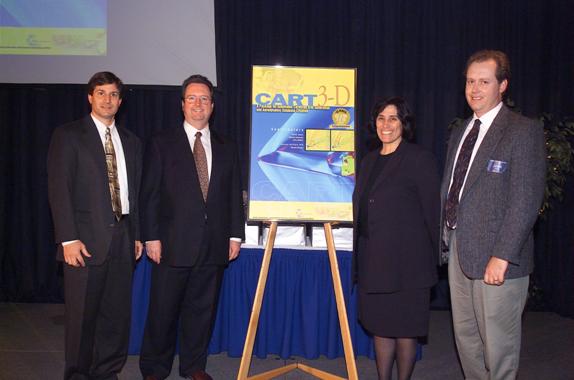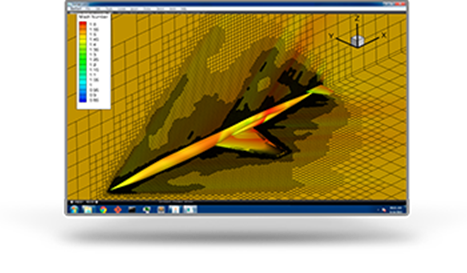

Invention of the Year Awards for 2002
Empirical Mode Decomposition, also known as the Hilbert Huang Transformation (HHT) is the winner of the 2002 NASA Government Invention of the Year. The HHT method has proven its versatility and value at NASA and throughout the Government. The HHT is currently used by the Laboratory for Hydrospheric Sciences at NASA’s Goddard Space Flight Center to analyze sea surface temperature data collected by the NASA Nimbus 7 Scanning Multichannel Microwave Radiometer. The HHT has been used on images collected by the National Oceanographic and Atmosphere Administration (NOAA) Advanced Very High Resolution Radiometer (AVHRR) sensor. There are known artifacts in the data collected due to a drift of one to two hours in local overpass time of the satellite. The HHT is being used in the data post-processing mode to correct the data. HHT has also proven successful in connecting environmental changes to El Nino phenomena.
Another successful application of HHT is the fusion of data between different sensors, in particular, fusion between data from Sea-viewing Wide Field-of-view Sensor (SeaWiFS) Project and AVHRR. The Laboratory for Terrestrial Physics at Goddard is also applying the HHT to numerical simulations in fluid dynamics. The time history of a given point in a flow is a one-dimensional data set, which the HHT is being used to analyze. Since fluid dynamics is a nonlinear process, this transform offers insight beyond that possible with standard Fourier methods. It has also been used for voice identification in law enforcement; e.g., for cell phone intercepts.
The Commercial Invention of the Year Award for 2002 was presented to the Video Image Stabilization and Registration (VISAR) system. VISAR, developed at NASA’s Marshall Space Flight Center, does what other image stabilization processes cannot do - it corrects for changes in orientation and size. In its current usage VISAR takes just seconds to do what Hathaway and Meyer took days to do before its invention, and it does a better job. This capability is critical for many video applications that arise in aerospace, commercial, consumer, and government operations. It has played a critical role in specific applications within solar physics research, forensics, and medical research. Without VISAR, the usefulness of the video data in these investigations would have been severely compromised. VISAR is a vital tool in the Columbia investigation.
Software of the Year Awards for 2002
The DSMC Analysis Code (DAC) software, developed at NASA’s Johnson Space Center, is used to provide the highest available fidelity predictions of plume impingement for orbiting structures. Distribution of U.S. Space Shuttle RCS plume loads on the Russian Mir Space Station at a distance of 5 meters while exercising a Norm-Z burn. DAC software provides NASA scientists and engineers with an easy to use, state-of-the-art, three-dimensional, implementation of the Direct Simulation Monte Carlo (DSMC) method that can be applied to a broad base of critical Agency low-density flow problems. DSMC, which performs a direct physical simulation of a gas at the molecular level, is widely recognized as the de facto standard for computationally predicting low-density flows.
Some examples of use in critical NASA applications include defining a vehicle's aerodynamics and aerothermodynamics for the initial portion of a reentry into an atmosphere, aerobraking maneuvers such as those recently employed by planetary probes in the rarefied portion of a planet's atmosphere, rarefied environments generated on-orbit through the use of reaction control system (RCS) thrusters for maneuvering, the venting overboard of waste gases and outgassing of materials on-orbit. Other rarefied gas dynamics applications would include deposition of electrical pathways for microelectronic circuit boards, and fluid mechanics applications for Micro Electro-Mechanical Systems (MEMS) devices.
Cart3D, developed at NASA’s Ames Research Center, is a high-fidelity geometry processing and flow analysis package that automates conceptual and preliminary aerodynamic design. Cart3D's approach to geometry processing and space discretization has had a worldwide impact on the simulation of complex geometries in fields outside of aerospace ranging from astrophysics to computer science and electromagnetics.
The work of the Cart3D development team consisting of over 25 technical papers, lecture series, course notes, and book chapters has been cited in more than 100 different technical and refereed journal articles from around the world. The current licensee of the Cart3D package is an industrial simulation provider, ICEM/CFD, a subsidiary of ANSYS, Inc. for use in the aerospace, electronics/electromagnetics, automotive, turbomachinery, and industrial process industries.
 ICB Home
ICB Home Back
Back

